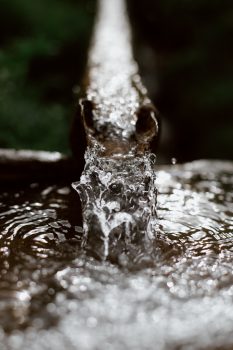 One of the things we have observed during yard surveys is that watering—providing the right amount at the right time and in the right place—can be a struggle.
One of the things we have observed during yard surveys is that watering—providing the right amount at the right time and in the right place—can be a struggle.
Here’s a review of tips to help you be more water wise when maintaining your yard:
Before you start…
- Adjust your sprinklers so that they are watering your lawn and garden, and not the street or sidewalk.
- Inspect your overall irrigation system for leaks, broken lines, or blockage in the lines. You may need to check this frequently during the watering season.
- Add a shut-off nozzle to your garden hose and save about 5-7 gallons each minute your hose is on.
- Group plants with like watering needs. Creating “watering zones” in your garden will allow you to give each plant the water it requires—not too much or too little.
When to water…
- It is best to water early in the morning (before 10:00 am), when temperatures are cooler and evaporation is minimized. You could also water in the evening but it is often windy then and water on leaves can lead to mildew.
- It is better to water the lawn and established plants less frequently and deeply rather than watering a little bit each day. Twice a week usually works. Doing this will help your plants establish robust root systems that are better able find the water they need in your soil and withstand warmer temperatures. Plants that are in pots and newly planted ones will need more frequent water- ing when it is hot.
How long, how much to water…
- Set it, but don’t forget it! Whether you have a manual or automatic system, be sure to adjust your watering schedules throughout the irrigation season.
- Water established lawns about 1 inch per week, more during hot, dry weather. Find out how much to water each week with the Weekly Watering Number.
- While it may be more work to adjust the amount you water your landscape throughout the summer, the extra effort will help you use water more efficiently in your landscape.
- Apply the amount of water your soil can absorb. If runoff or puddling occurs, break longer watering sessions into several short sessions allowing water to soak into the soil between each session. To do a “cycle and soak” pattern for your watering, apply water in several shorter sessions each day that you water. This will allow the water to soak gradually into the soil in be- tween watering sessions. For example, if your water- ing schedule is 40 minutes per week and you plan to water two days per week, your new “cycle and soak” schedule might be to water for 10 minutes at 6:00 a.m. and then again for 10 minutes at 8:00 a.m. on both of your watering days.
Other considerations…
- Consider replacing some turf area with low water-use plants and ornamental grasses. They are easier to maintain than turf, look beautiful, and require far less water.
- Adjust your mower to a higher setting. A taller lawn provides shade to the roots and helps retain soil moisture, so your lawn requires less water.
- Steep slopes, sharp angles, and narrow driveways or sidewalk strips are difficult to water efficiently and are usually hard to mow. Consider using ground covers, low water-use plants, and mulches for these areas. Ground covers offer much of a lawn’s neatness and uniformity, but require less maintenance. Hardscape features are another way to enhance the functionality of your yard while helping you rely less on irrigation. In high use areas consider putting in pathways or patios made of wood, rock, or gravel that allows water to drain through.
– By Lu Ann Staul Community Carbon Team Leader at St. Andrew Lutheran
To sign up to receive these blog post directly to your email account, click here or on the link in the upper right sidebar of any page at ecofaithrecovery.org. You can also learn how to engage in our Community Carbon initiative here.
Please feel free to share this post with others and use the field below to post your thoughts on this topic. Thanks!
